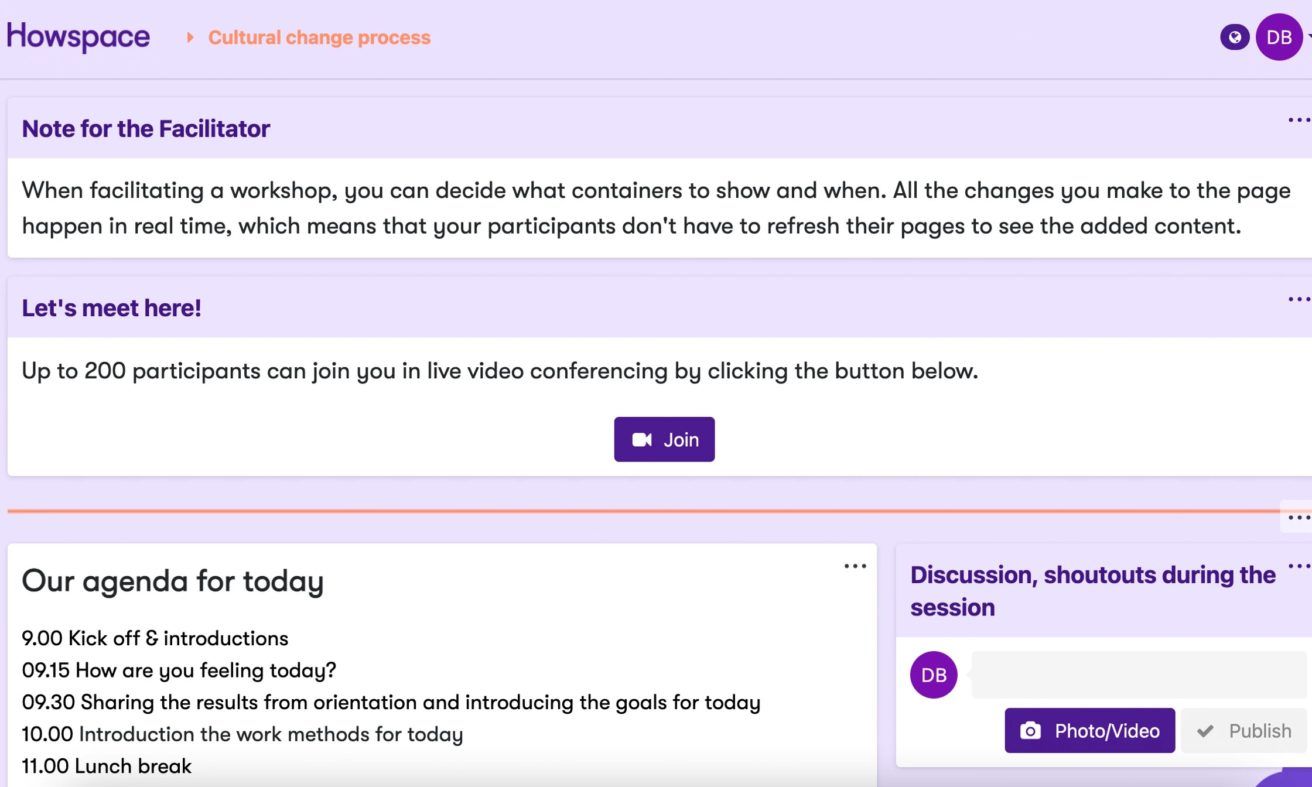
Human-centric transformation: What is it and why does it matter?
Human-centric transformation has been around for a while, but it has been difficult for consultants, transformation leaders, and others driving change to put into practice.
With the development of technology, it’s become easier to involve many people in a transformation process with synchronous workshops and asynchronous interactions. Platforms like Howspace allow you to engage people in a transformation process—regardless of location and time zone.
But what exactly is human-centric transformation? Why is it especially relevant today, and how can you design and lead a human-centric transformation process?
What is human-centric transformation?
To define human-centric transformation, let’s break down both the terms “human-centric” and “transformation.” First, being human-centric means seeing people—their values, thoughts, and experiences—as most important. Transformation is about modifying long-term behaviors and core beliefs to achieve a desired result.
Now putting both these terms together, human-centric transformation means inviting people to be an essential part of a transformation process. The transformation is not led by an organization’s upper management, but instead, everyone involved is invited to share their thoughts and insights, and be heard.
Every transformation happens in a certain culture, and taking this human-centric approach means developing the organization’s culture to revolve around its people.
“I believe successful transformation and change is primarily a social process built on dialogue and co-creation. A process where people can create something new together, and feel the joy and excitement of collaboration. In this human-centric approach, leaders act more as facilitators of conversations, discovery, sense-making, and do less of ‘managing change’.”
Martin Aldergard, Senior Partner at ENPEO Consulting Co., Ltd.
Why is human-centric transformation important?
If you want to be successful with any kind of transformation or change initiative, you need to invite everyone to be part of the process.
Feeling heard is a human need. People want to be able to share their deepest thoughts and insights. If you can truly support this as a consultant or a leader, the outcome of your transformation process will always be better for two reasons: 1) When you take people on the journey with you, there will be less change resistance, and 2) When you invite people to share their unique perspectives, you’ll get better ideas and make space for innovation.
How can you encourage people to openly say what they truly think? Create a trusting environment and strengthen the feeling of psychological safety. By doing so, you’ll prevent people from only daring to share their thoughts in corridor conversations, which you won’t be privy to.
Especially at the beginning of the journey, give people the chance to talk about their worries or concerns. Only by listening to those concerns can you get people onboard with the transformation.
To further build trust, be transparent in all phases of a transformation process. Don’t ask people to answer a survey only to share the results three months later and take actions that aren’t connected to their responses. Instead, ensure everyone understands that decisions are made together, based on their input.
“Creating the power within a group to sense, think, and act together makes mountains move. Systemic thinking and technology ignite the next step in human centric transformation. Howspace makes it practical and fun.“
Rik Berbe, Change Guide and Workshop Facilitator at ChangeLab
What’s the difference between change management and human-centric transformation?
Change management is typically more destination-oriented, with a clear schedule and endpoint. With transformation, the journey—built together with everyone—is the most important aspect.
You need to know the purpose of the transformation and what you’re trying to achieve, but you don’t need to predict the final outcome. It’s important you aren’t too certain about what the end result of the transformation should be. In fact, if you already know what exactly should happen with the transformation, then don’t even start the process. Transformation is experimental in nature—you can do different experiments and see where they take you. Instead of focusing on the final destination, focus on how well you have developed and been able to do things differently.
Whereas change can be small and incremental, transformation happens on a larger scale and is more significant. Rather than build a schedule for a transformation process, you can create checkpoints to identify how things have developed. You want to be constantly learning from your experiments to steer the transformation process in the direction you want to go.

What skills and practices are needed to lead the human-centric transformation?
- Curiosity: Be genuinely curious about other people’s thoughts, opinions, and experiences.
- Active listening: Carefully listen to what people are saying and aim to understand what’s on their minds.
- The CDE Model: You can use the CDE model (container, differences, exchanges) to lead a transformation process. Some questions you can ask yourself, based on this model, include: Are we aware of what we’re heading into? What’s keeping everyone together on the journey? Do we have enough diversity in our group so that different viewpoints are easy to collect? Do we have enough possibilities to change our thoughts?
- Howspace Template for Leading a Change Process: If you are leading a cultural change, you can also start with the Leading a Change Process Howspace Template to kick off your journey. This practical process template walks you through the whole process of involvement-based cultural change from communicating the need for change to integrating it into the day-to-day.
“According to the World Economic Forum, active learning and learning strategies will be number two on the list of top 10 skills of 2025. Well, there is a long way to go from classroom teaching to self-driven learning, team-based learning, or digital co-creation. Human-centric transformation could be a perfect solution for the challenges we are facing in learning new skills for the future (or even for today).“
Riitta Hyppänen, business coach, trainer, and writer. CEO at CM & HR Consulting Oy.
Facilitating human-centric transformation is the skill of the future
Whether you’re an IT or management consultant supporting your clients in large-scale transformation or a leader wanting to build a better company culture, being able to facilitate transformation in a human-centric way will set you up for success.
Learn more about what the human-centric approach to transformation looks like and how you can drive transformation digitally here and contact us here.
Check out our free template Leading a Change Process! This practical process template walks you through the whole process of involvement-based cultural change from communicating the need for change to integrating it into the day-to-day.
Already a Howspace-user? You can add the template to your account here.

You might be interested in these as well
View all
Make Your Decision-Making More Inclusive and Effective
Participatory decision-making taps into the collective wisdom of your entire workforce. Here’s how to make more impactful decisions in your organization.

The best change management tools for successful organizational transformation
Embracing change within organizations can be challenging, as people naturally resist it. However, utilizing the right change management software can […]

Top 7 Virtual Organizational Transformation Strategies
When it comes to organizational transformation strategies and how to effectively lead change in a virtual environment, my pro tip […]